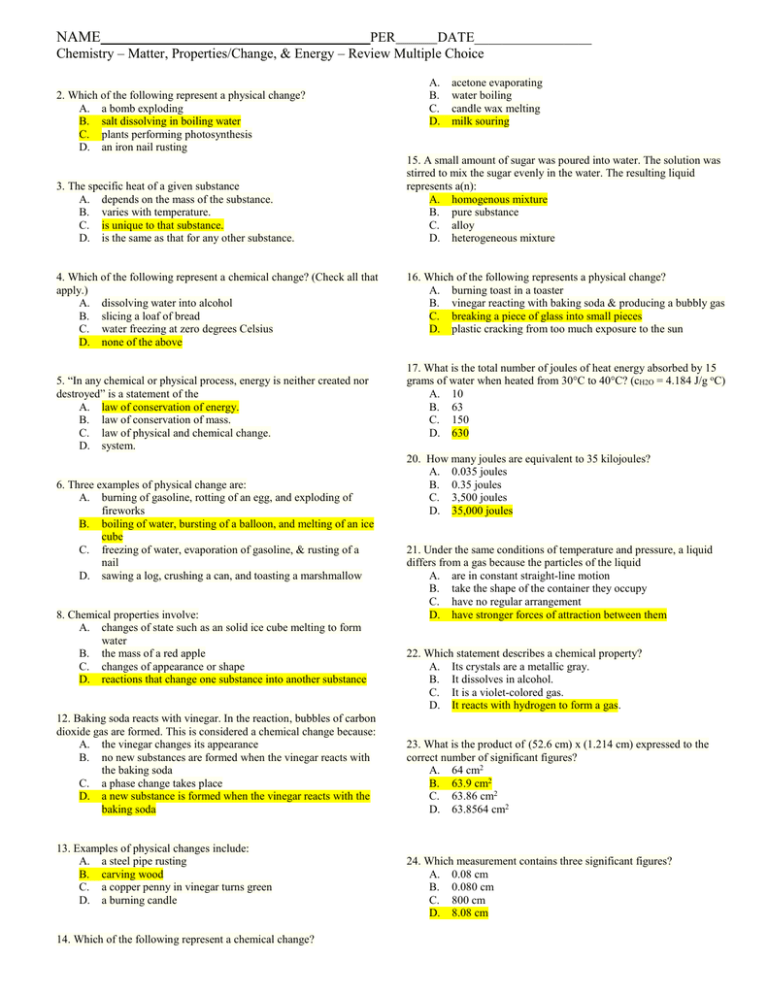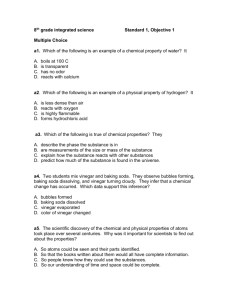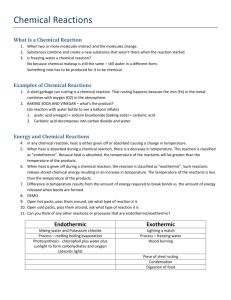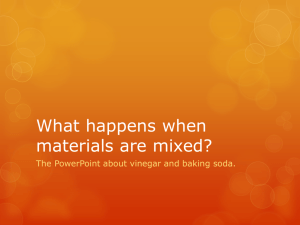Chemistry Review: Matter, Properties, Energy - Multiple Choice
advertisement

NAME PER DATE_________________ Chemistry – Matter, Properties/Change, & Energy – Review Multiple Choice 2. Which of the following represent a physical change? A. a bomb exploding B. salt dissolving in boiling water C. plants performing photosynthesis D. an iron nail rusting 3. The specific heat of a given substance A. depends on the mass of the substance. B. varies with temperature. C. is unique to that substance. D. is the same as that for any other substance. 4. Which of the following represent a chemical change? (Check all that apply.) A. dissolving water into alcohol B. slicing a loaf of bread C. water freezing at zero degrees Celsius D. none of the above 5. “In any chemical or physical process, energy is neither created nor destroyed” is a statement of the A. law of conservation of energy. B. law of conservation of mass. C. law of physical and chemical change. D. system. 6. Three examples of physical change are: A. burning of gasoline, rotting of an egg, and exploding of fireworks B. boiling of water, bursting of a balloon, and melting of an ice cube C. freezing of water, evaporation of gasoline, & rusting of a nail D. sawing a log, crushing a can, and toasting a marshmallow 8. Chemical properties involve: A. changes of state such as an solid ice cube melting to form water B. the mass of a red apple C. changes of appearance or shape D. reactions that change one substance into another substance 12. Baking soda reacts with vinegar. In the reaction, bubbles of carbon dioxide gas are formed. This is considered a chemical change because: A. the vinegar changes its appearance B. no new substances are formed when the vinegar reacts with the baking soda C. a phase change takes place D. a new substance is formed when the vinegar reacts with the baking soda 13. Examples of physical changes include: A. a steel pipe rusting B. carving wood C. a copper penny in vinegar turns green D. a burning candle 14. Which of the following represent a chemical change? A. B. C. D. acetone evaporating water boiling candle wax melting milk souring 15. A small amount of sugar was poured into water. The solution was stirred to mix the sugar evenly in the water. The resulting liquid represents a(n): A. homogenous mixture B. pure substance C. alloy D. heterogeneous mixture 16. Which of the following represents a physical change? A. burning toast in a toaster B. vinegar reacting with baking soda & producing a bubbly gas C. breaking a piece of glass into small pieces D. plastic cracking from too much exposure to the sun 17. What is the total number of joules of heat energy absorbed by 15 grams of water when heated from 30°C to 40°C? (cH2O = 4.184 J/g oC) A. 10 B. 63 C. 150 D. 630 20. How many joules are equivalent to 35 kilojoules? A. 0.035 joules B. 0.35 joules C. 3,500 joules D. 35,000 joules 21. Under the same conditions of temperature and pressure, a liquid differs from a gas because the particles of the liquid A. are in constant straight-line motion B. take the shape of the container they occupy C. have no regular arrangement D. have stronger forces of attraction between them 22. Which statement describes a chemical property? A. Its crystals are a metallic gray. B. It dissolves in alcohol. C. It is a violet-colored gas. D. It reacts with hydrogen to form a gas. 23. What is the product of (52.6 cm) x (1.214 cm) expressed to the correct number of significant figures? A. 64 cm2 B. 63.9 cm2 C. 63.86 cm2 D. 63.8564 cm2 24. Which measurement contains three significant figures? A. 0.08 cm B. 0.080 cm C. 800 cm D. 8.08 cm




